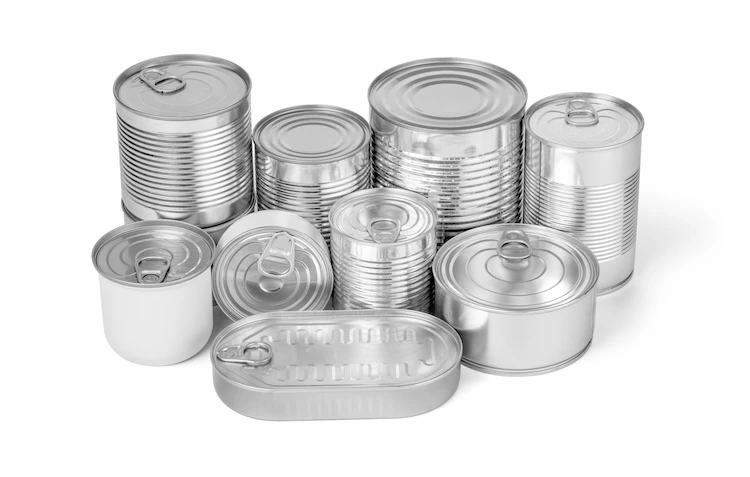Application
Tin-plated sheet, commonly known as tinplate, is a low-quality sheet with tin-plated surface, and tin-plated by hot-dip process is called hot-dip tinplate;
Tin plating by electroplating process is called electroplated tin plate.
The corrosion resistance of the steel sheet is enhanced after tin plating, and the ductility and workability are further improved.
This is because the steel plate is tinned, and a dense layer of tin-iron alloy is formed between the inner layer of steel and the outer layer of tin, and this thin layer of alloy has good corrosion resistance.
The pre-nickel-plated steel sheet developed in Japan not only improves the weldability of the original plate, but also improves the corrosion resistance and paint adhesion of the original plate.

In addition, there is a chrome-tin two-layer steel plate made of a layer of metal chrome (100mg/m2) firstly plated on the original plate, and then a layer of tin (0.1~0.3g/m2).
This steel plate has good weldability and corrosion resistance, reduces the cost of painting, and can be baked at high temperatures for a short time.
The special tinplate for packaging adopts the method of insoluble anodizing, which is simple in process, high in efficiency, uniform and firm in coating, and can achieve positive and negative plating with different thicknesses, effectively avoiding the phosphoric acid and chromium caused by the need for pickling in hot dip plating.
Therefore, it can save the cost of wastewater treatment and reduce the pollution to the environment.
In packaging applications, tin-plated steel plates are often coated on the inside of the container, that is, the side that is in contact with the article, and then dried before packaging food and other contents.
The coating is dense and uniform, has good adhesion to the surface of the tin-plated sheet, and is not easy to fall off and be damaged during processing.
The raw materials of this coating are mostly epoxy resin, phenolic resin, etc., which are non-polluting to food, harmless to the human body, and have good anti-corrosion properties, which can prevent the deterioration of oil and medium in food, thereby effectively protecting the quality of food.
The welding of tinplate cans adopts high-frequency resistance welding technology, which can not only reduce pollution but also improve welding quality.
The biggest feature of tinplate is that it is anti-corrosion and easy to process.
It can be punched and welded, which is convenient for installation and printing.
It is non-toxic and harmless, so it is suitable for the packaging of various foods, beverages, and medicines.
At present, it is mainly used as a packaging material for canned food.
In recent years, the French steel company first developed a new type of tinplate for packaging and put it into the market, causing a revolution in the packaging industry.
According to the different requirements of the packaging industry, the thickness of the tinplate material, the amount of tin plating, and the mechanical properties have different needs.
At present, the thickness of materials used to make three-piece cans in Europe is 0.13 ~ 0.21mm, which not only saves steel and reduces costs, but also does not reduce the requirements of all aspects of the product.
According to the statistics of European countries, enterprises can obtain 20% of the profit by reducing the thickness of the material, which is much higher than the profit obtained by reducing the price of the can by 3-4%.
At present, France’s tinplate production accounts for 40% of the European market, and it is growing at a rate of 8%, mainly due to the development of special materials for different purposes.
In Europe, some can-making companies have begun to produce tinplate two-piece cans, but the equipment has not changed much, and the production equipment of aluminum two-piece cans is still used.
By replacing aluminum cans with steel, the cost can be reduced by 15-18%, and the mechanical strength of the cans can be increased by more than 60%.
At present, the general development trend of tinplate for packaging is: reducing the thickness of the material and improving the mechanical properties of the material.
The main types of tinplate products for packaging are three-piece tinplate for cans, tinplate for spray cans and cosmetic cans, tinplate for closure lids and crown lids, tinplate for paint and chemical product containers, and tinplate for two-piece cans, tinplate for special-purpose packaging, etc.
Tinplate for beverage cans.
The characteristics of this kind of tinplate for beverage cans are high purity, no impurities, and more corrosion resistance; the drawing width can reach 1200mm;
The shape is very regular, and the dimensional error is small; continuous annealing, good toughness.
On the basis of ensuring the good performance of tinplate, it can greatly reduce its thickness, so that tinplate has superior mechanical properties and plasticity.
Tinplate for food cans.
Currently, a range of tinplates produced in Europe can be used to produce many different types and shapes of food cans. These tinplates are mainly continuous coated tinplates (for DRD-coated can bottoms), tinplates for easy-open lids, and tinplates for stretch cans.
Among them, the tinplate used in the production of ultra-thin cans and crown caps makes opening the bottle very safe and reliable.
Tinplate for spray cans and cosmetic cans.
Tinplate for packaging is suitable for the manufacture of high-pressure spray cans, making this container in line with international standards and environmentally friendly.
Tinplate for paint and chemical product containers.
Due to the excellent impact resistance and flame retardancy of special tinplate for packaging, using these packaging containers to package coatings and paints not only meets the relevant regulations on the transportation and storage of toxic substances, but also allows manufacturers to save a lot of insurance costs.
Tinplate for special purpose packaging.
Tinplate for special purpose packaging has good printability and is most suitable for printing containers of various shapes.
